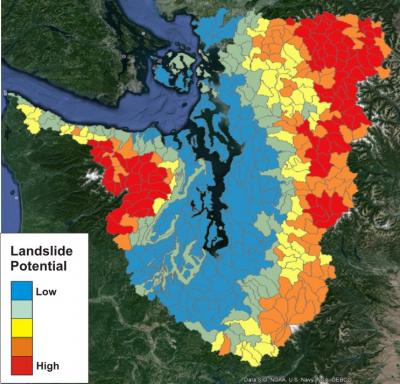 BigPicView: Your Portal to Large Scale Patterns of Environmental and Land Use (coming early Feb. 2014)
BigPicView: Your Portal to Large Scale Patterns of Environmental and Land Use (coming early Feb. 2014)
NetMap's Digital Landscapes are typically packaged at the scale of 8 digit, 4th level Hydrologic Unit Code (HUC) boundaries. The Sort & Rank Tool in NetMap is used to classify any NetMap attribute at the scale of HUC 6th level (12 digit), as seen to the right.
However, analysts and planners may wish to display and analyze patterns of environmental properties and land use activities at much larger scales, at aggregate NetMap Digital Landscapes scales.
To make life simpler, the online (non Arc) BicPicView tool allows subscribers of NetMap to quickly examine large scale patterns that encompass entire watersheds, landscapes, national forests and states. The map display or analysis extent is referred to "scope"; the spatial scale of the analysis is referred to as "scale". Examples follow.
 A user can select a "scope" of a HUC 3 that encompasses all watersheds draining into Puget Sound in Washington State. Next, they select a scale at which they want to see their selected attribute which must be smaller in scale that the scope, e.g., HUC 4th, 5th or 6th. Shown to the right is a 6th level HUC scale displaying coho salmon habitat potential.
A user can select a "scope" of a HUC 3 that encompasses all watersheds draining into Puget Sound in Washington State. Next, they select a scale at which they want to see their selected attribute which must be smaller in scale that the scope, e.g., HUC 4th, 5th or 6th. Shown to the right is a 6th level HUC scale displaying coho salmon habitat potential.
 A user can also quickly select another attribute from the drop down list to display for the same "scope", for example landslide potential.
A user can also quickly select another attribute from the drop down list to display for the same "scope", for example landslide potential.
 In addition to displaying various NetMap and other GIS data layers at various "scopes" and "scales", users can quickly search for overlaps of stressors with valuable habitats. In the example shown to the right an analyst quickly searches for the specific 6th level HUCs where the top 10% of coho habitat potential (at the scale of the entire Puget Sound basin) overlaps with the top 5% of shallow landslide potential.
In addition to displaying various NetMap and other GIS data layers at various "scopes" and "scales", users can quickly search for overlaps of stressors with valuable habitats. In the example shown to the right an analyst quickly searches for the specific 6th level HUCs where the top 10% of coho habitat potential (at the scale of the entire Puget Sound basin) overlaps with the top 5% of shallow landslide potential.
 In addition to "scopes" of HUC levels (3, 4, 5), the BigPicView also uses "scopes" of certain agency jurisdictional boundaries, such as US Forest Service Regions, National Forests and Districts. For example, at the right is the entire Deschutes National Forest (eastern Oregon) displaying abundance of anadromous fish habitats at the scale of HUC 6.
In addition to "scopes" of HUC levels (3, 4, 5), the BigPicView also uses "scopes" of certain agency jurisdictional boundaries, such as US Forest Service Regions, National Forests and Districts. For example, at the right is the entire Deschutes National Forest (eastern Oregon) displaying abundance of anadromous fish habitats at the scale of HUC 6.
 As in the Puget Sound, an analyst can also select from other attributes in the drop down list, for example erosion potential.
As in the Puget Sound, an analyst can also select from other attributes in the drop down list, for example erosion potential.
 Or a user can select as "scope" of national forests and a scale of districts and data will be summarized displayed accordingly.
Or a user can select as "scope" of national forests and a scale of districts and data will be summarized displayed accordingly.
